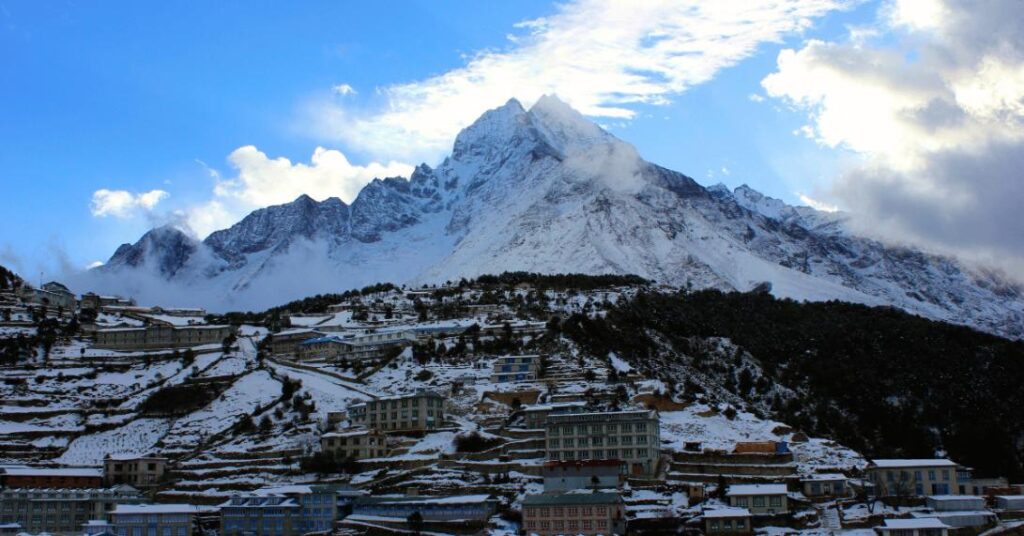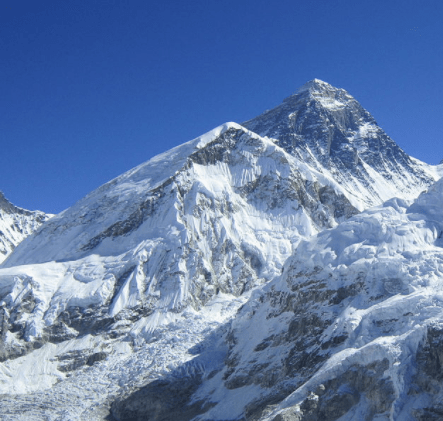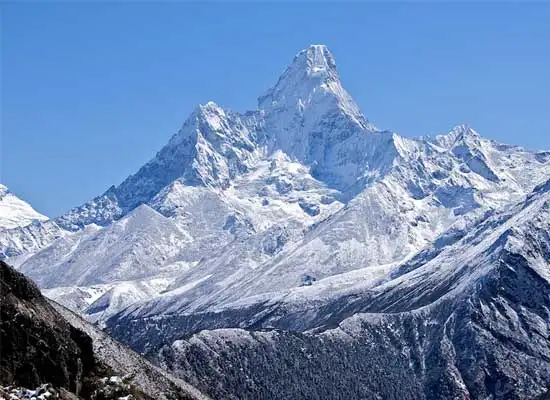Introduction
The Everest Base Camp hike is an iconic trek in Nepal that leads adventurers to the base camp of the famous Mount Everest. It is considered a rite of passage for trekkers and offers a thrilling opportunity to experience the inspirational beauty of the highest summit on Earth.
In this article, we will provide a detailed account of the journey from preparation to achievement, highlighting key aspects along the way.
This comprehensive guide aims to equip aspiring trekkers with valuable information and insights to ensure a successful and fulfilling experience. Whether you are a seasoned hiker or a beginner explorer, this blog will offer you a wealth of knowledge to make the most out of your Everest Base Camp adventure.
Throughout the article, we will explore various topics including:
- Understanding the hike itself
- Planning for success
- Navigating the challenging terrain
- Exploring the local Sherpa culture
- Dealing with altitude sickness
- Managing costs
…..and much more
By providing practical tips, sharing personal experiences, and shedding light on important considerations, we aim to allow you with the necessary tools and knowledge to begin this life-changing journey.
So get ready to begin an unforgettable adventure where breathtaking views meet cultural exploration.
Let’s understand the details of the Everest Base Camp Hike and discover how you can turn your preparation into a remarkable achievement.
Table of Contents
1. Understanding the Everest Base Camp Hike
The Everest Base Camp hike is a legendary journey that takes trekkers to the base camp of Mount Everest, the highest summit on Earth. Located in Nepal, this iconic trek offers a once-in-a-lifetime experience that combines breathtaking natural beauty with a sense of achievement and adventure.


What is the Everest Base Camp Trek?
Situated at an altitude of 17,598 feet, the Everest Base Camp Trek is a renowned trekking destination in the Himalayas of Nepal. It offers adventure lovers breathtaking views and a challenging journey to the base camp of the world’s highest mountain, Mount Everest. It requires physical fitness, mental resilience, and a very careful planning. However, the rewards are exceptional. As you make your way through the tough terrain, you will be rewarded with spectacular views of snow-capped peaks, glacial lakes, and pleasing valleys.
The Journey to Everest Base Camp
Reaching the base camp itself is a monumental achievement. Standing at the foot of Mount Everest, you will feel an intense sense of accomplishment. The absolute magnitude of the world’s highest peak will leave you humbled and inspired.



Understanding Nepalese Culture
But it is not just about conquering mountains; it’s also about engrossing in the rich culture and traditions of Nepal. Along the trek, you will encounter Sherpa villages, Buddhist monasteries, and prayer flags fluttering in the wind that will make you feel like you are in a different world altogether. You’ll have the opportunity to interact with local Sherpas and learn about their way of life.
A Transformative Journey
The Everest Base Camp Trek is more than just a physical challenge; it’s a transformative journey that pushes you beyond your limits and leaves you with memories that will last a lifetime. Whether you’re an experienced trekker or a beginner, this trek offers an experience like no other.
So lace up your hiking boots, pack your backpack, and get ready to go on an unforgettable adventure to the base camp of Mount Everest.
2. Planning for Success: Duration, Best Time, and Essential Gear
When getting ready for the Everest Base Camp hike, it’s important to plan ahead so that you can have an amazing experience without backlogs. In this section, we’ll go over how long the Everest Base Camp hike usually takes, when is the ideal time to go, and what gear you will need to bring with you.

Duration: How long does it take?
The Everest Base Camp hike typically lasts for about 12-14 days. It is very important to give yourself enough time to adjust to the high altitudes as you go up. This gradual climb helps your body get used to the lower levels of oxygen and lowers the chances of getting altitude sickness. Also, taking breaks every now and then allows your body to rest and adapt to the increasing altitude.
Best Time to Trek: When should you go?
The two best seasons for a successful and safe journey to the base camp are spring (late March to May) and autumn (late September to November). During these times of the year, the weather is generally good, with clear skies and moderate bearable temperatures. Spring offers beautiful rhododendron flowers along the trail which will be quite a lovely sight, while the autumn treats you with breathtaking views of colorful foliage.

Essential Gear: What do you need?
To make sure that your trek is comfortable and safe, it’s important to have the right gear with you. Here’s a checklist of things that you must bring:
- Hiking boots: Get yourself a strong pair of hiking boots that support your ankles well and have good grip.
- Layered clothing: Pack light layers of clothes that wick away moisture, keep you warm, and protect you from rain or snow.
- Sleeping bag: Choose a sleeping bag that can handle cold temperatures (-10°C/14°F) so that you stay cozy during chilly nights.
- Backpack: Pick a backpack that can hold all your essentials and has a capacity of at least 40-50 liters.
- Trekking poles: These will give you extra stability and reduce the strain on your knees when you’re going downhill.
- Headlamp: A headlamp is very useful for early morning hikes and when it’s dark outside.
- First aid kit: Make sure to have basic medications, blister pads, and sterile bandages in case of any injuries.
- Water purification: Carry a water purification system so that you can have clean drinking water throughout the trek.
Remember to pack light and focus on what is important. We at Himalayan Trekking and Tours and our guide will be able to provide you with a detailed list of gear that suits the specific requirements of the Everest Base Camp hike.
By planning for enough time, selecting the right season, and having the necessary gear with you, you will be setting yourself up for a fantastic journey to the base camp.





3. Best Landmarks Along the Everest Region
The Everest Base Camp trek is filled with iconic landmarks that offer trekkers a deeper connection to the region’s natural and cultural heritage. These key landmarks serve as significant milestones along the journey, providing breathtaking views and insights into the local way of life.
Kala Patthar Lookout
This renowned vantage point offers a panoramic view of Mount Everest, allowing trekkers to witness the extraordinary grandeur of the world’s highest peak. The sight from Kala Patthar is often described as a culmination of the trek, providing a sense of accomplishment and reverence for the Himalayan landscape.
Gorak Shep Settlement
As the final outpost before reaching Everest Base Camp, Gorak Shep serves as a vital resting point for trekkers. Despite its rough terrain, the settlement offers a unique perspective on life in the high Himalayas, surrounded by towering peaks and vast glaciers.
Sagarmatha National Park Museum
Located in Namche Bazaar, this museum showcases the rich biodiversity and cultural heritage of the Everest region. Trekkers have the opportunity to gain valuable insights into the local flora, fauna, and indigenous Sherpa communities, enriching their understanding of this unique ecosystem.
Tengboche Monastery
Regarded as one of the most sacred monasteries in the Khumbu region, Tengboche Monastery stands as a testament to Sherpa spirituality and tradition. Its serene ambiance and intricate architecture make it a spiritual oasis amidst the rugged mountain terrain, offering trekkers a glimpse into the spiritual heart of the Everest region.
These landmarks not only punctuate the physical journey but also provide trekkers with a profound sense of connection to the natural wonders and cultural tapestry of the Everest region.
4. Navigating the Terrain: Challenges and Rewards
Trekking to Everest Base Camp involves navigating through diverse terrain, each presenting its own set of challenges and rewards. From alpine terrain to scree-covered ridges and thrilling suspension bridges, this section explores what trekkers can expect along the way.

Thrill of Diverse Terrain
The Everest Base Camp trek takes you through a range of landscapes, from rocky paths to alpine meadows. As you ascend higher, you’ll encounter scree-covered ridges and boulder strewn trails, adding an element of adventure to your journey. The ever-changing terrain keeps you engaged, with every step offering a new vista to admire.
Suspension Bridges: A Test of Courage
One of the most exhilarating aspects of the trek are the suspension bridges that span gorges and rivers. These swaying bridges may challenge your courage, but they also offer a unique thrill and a chance to conquer your fears. Crossing these bridges requires focus and steady footing, but the reward is well worth it as you continue on your path towards Everest Base Camp.
Challenges at High Altitude
As you ascend higher into the Himalayas, altitude becomes a significant challenge. The thin air can cause symptoms of altitude sickness such as headaches, dizziness, and nausea. To overcome these challenges, proper acclimatization is crucial. It is recommended to include rest days at key points during the trek to allow your body to adjust to the altitude gradually.
Rewards of Overcoming Challenges
While navigating through challenging terrain and high altitudes may seem daunting, the rewards are immeasurable. Each step towards Everest Base Camp brings you closer to one of the world’s most iconic mountains. Standing at the base camp itself is an achievement that fills trekkers with a deep sense of awe and accomplishment.
By embracing the challenges that come with navigating diverse terrain and overcoming the obstacles of high altitude, trekkers on the Everest Base Camp hike can experience the true essence of adventure and revel in the rewards that await them at every turn.





5. Exploring Local Sherpa Culture
The Everest Base Camp Trek offers a unique opportunity for trekkers to immerse themselves in the rich and vibrant Sherpa culture that thrives in the Everest region. As you traverse through the picturesque landscapes and charming villages, you’ll have the chance to engage in meaningful cultural exchanges and gain insights into the traditions and way of life of the Sherpa people.
Highlights of the Sherpa Cultural Experiences Along the Trek
Here are some key highlights of the Sherpa cultural experiences along the trek:
- Glimpse into Traditional Lifestyle: Witness firsthand the daily routines and traditional practices of the Sherpa community, from their distinctive clothing to their architectural style of homes and monasteries.
- Interaction with Locals: Engage in friendly interactions with local Sherpas, who are known for their warmth and hospitality. This presents an excellent opportunity to learn about their customs, beliefs, and folklore directly from the source.
- Visit Buddhist Monasteries: Explore ancient Buddhist monasteries such as Tengboche Monastery, where you can observe religious rituals, intricate murals, and perhaps even participate in meditation sessions led by resident monks.
- Cultural Festivals: Depending on the timing of your trek, you may have the chance to witness or even partake in traditional Sherpa festivals or ceremonies, offering a deeper understanding of their spiritual and cultural heritage.
By embracing these cultural encounters, trekkers can gain a profound appreciation for the enduring traditions and values that define the Sherpa way of life.
6. Dealing with Altitude Sickness: Risks and Prevention
Altitude sickness, also known as Acute Mountain Sickness (AMS), is a common concern for trekkers on the Everest Base Camp Hike due to the high altitudes reached during the trek. It is important to understand the symptoms and risks of AMS in order to prevent its onset and ensure a safe and enjoyable journey. Here are some practical tips to help you manage altitude sickness:
Recognizing the Symptoms
- Headache
- Nausea or vomiting
- Loss of appetite
- Fatigue or weakness
- Dizziness or lightheadedness
- Difficulty sleeping
Proper Acclimatization
- Allow sufficient time for acclimatization by planning rest days at key points during the trek.
- Ascend gradually, avoiding rapid gains in altitude.
- Climb high and sleep low: During acclimatization days, hike to higher altitudes during the day and descend to lower altitudes to sleep.
Hydration and Nutrition
- Drink plenty of fluids, preferably water, to stay hydrated.
- Eat a balanced diet with enough calories to fuel your body’s needs.
Medication
- Consult with a healthcare professional about medications that can help prevent or alleviate AMS symptoms.
Listen to Your Body
- Pay attention to any signs of AMS and take them seriously.
- If symptoms worsen or do not improve with rest, it may be necessary to descend to lower altitudes.
Remember that everyone reacts differently to high altitudes, and fitness level does not necessarily correlate with susceptibility to AMS. It is essential to prioritize your health and safety throughout the trek.
By being aware of the risks and taking proactive measures to prevent AMS, you can increase your chances of a successful and enjoyable Everest Base Camp hike. Proper acclimatization, hydration, nutrition, and listening to your body are key to managing altitude sickness effectively.




7. The Cost Factor: Budgeting for the Adventure
When planning for the Everest Base Camp Hike, it’s essential to consider the various expenses involved in the journey. Understanding the cost factors can help trekkers make informed decisions and budget effectively for this adventure. Here’s a breakdown of the key financial aspects to consider:
Permit Fees
Trekkers are required to obtain permits for the Everest Base Camp Trek. The Sagarmatha National Park Entry Permit and the Khumbu Pasang Lhamu Rural Municipality Entrance Permit are mandatory. It’s important to factor in these permit fees when budgeting for the trek.
Accommodation
Along the route, trekkers will stay in teahouses, which offer simple yet comfortable lodging options. The cost of accommodation varies, and it’s advisable to have a rough estimate of daily expenses for lodging.
Meals
Teahouses also provide meals for trekkers. While the cost of meals may vary, having an approximate budget for daily food expenses is crucial for financial planning.
Trekking Packages
There are all-inclusive trekking packages available that cover permits, accommodations, meals, and guide services. Trekkers may opt for these packages for convenience, or choose independent budgeting, where they arrange accommodations and meals separately.
Understanding these cost factors can help trekkers plan their budget effectively and ensure a smooth financial experience throughout the Everest Base Camp Hike.
Conclusion
Begin on the Everest Base Camp hike, a life-changing adventure that will leave you in awe of the breathtaking views and immersed in the rich Sherpa culture. From the iconic trek to the base camp of Mount Everest, you will witness nature’s grandeur up-close and personal.
The journey offers a deep sense of accomplishment as you:
- Conquer diverse terrains
- Navigate suspension bridges
- Overcome altitude challenges through proper acclimatization
Explore the unique Sherpa culture along the way, experiencing their traditions and engaging in cultural exchanges. Allow yourself to be captivated by the panoramic views from the Kala Patthar viewpoint and find solace in the spiritual ambiance of Tengboche Monastery.
The Everest Base Camp hike is not just an adventure; it is an opportunity to discover your inner strength and resilience. So pack your bags, lace up your boots, and set out on this extraordinary expedition that promises to be a transformative experience of a lifetime.
“Climb mountains not so the world can see you, but so you can see the world.”
You may also like:
Send an Enquiry
Error: Contact form not found.
© 2025 - Himalayan Trekking and Tours (P) Ltd. All Rights Reserved.




